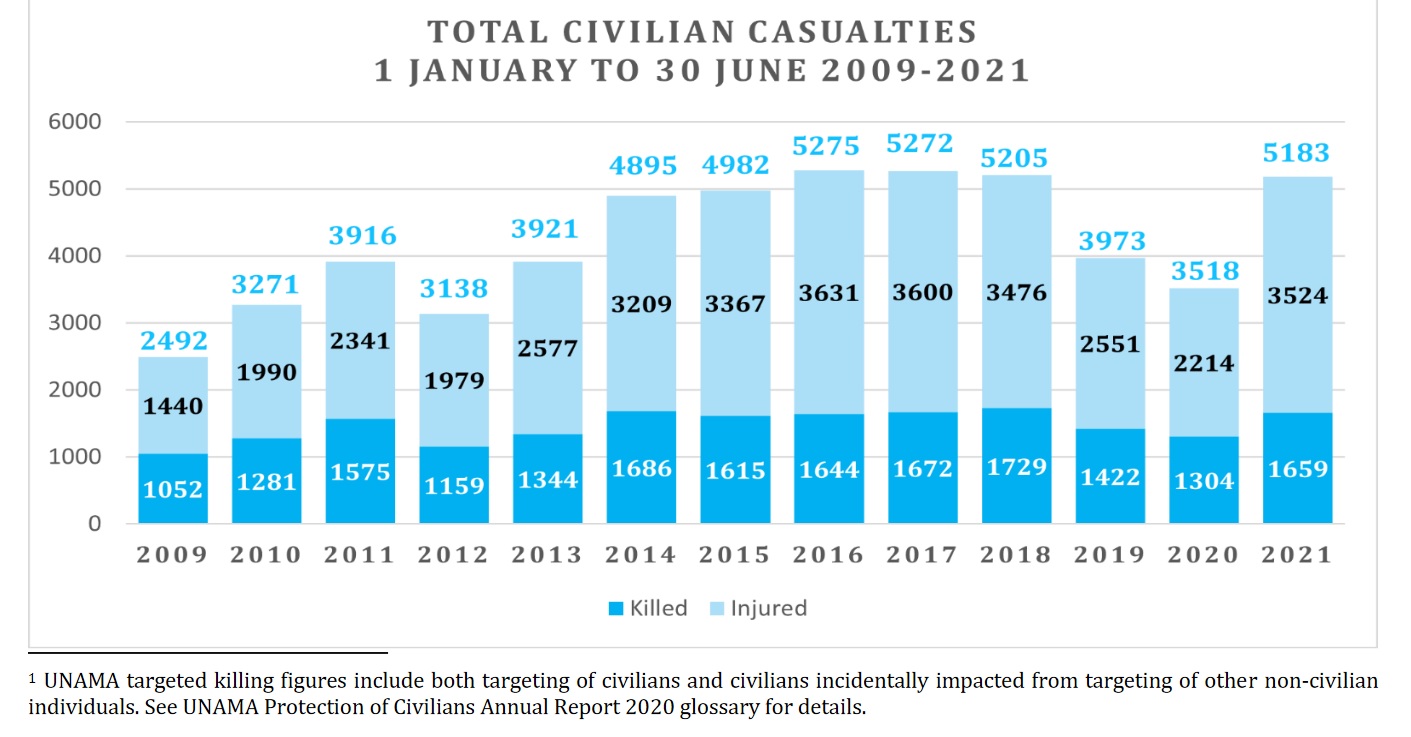Monitoring Desk: Between 1 January and 30 June 2021, the United Nations Assistance Mission in Afghanistan (UNAMA) documented 5,183 civilian casualties (1,659 killed and 3,524 injured).
The total number of civilians killed and injured increased by 47 percent compared with the first half of 2020, reversing the trend of the past four years of decreasing civilian casualties in the first six months of the year, with civilian casualties rising again to record levels seen in the first six months of 2014 to 2018.
One of the major reasons for the high number of human casualties is the untrained Afghan Air Force that is bombing its own civilian population. Airstrikes by Pro-Government Forces caused increased numbers of civilian casualties, mainly attributed to the Afghan Air Force.
Civilian casualties increased for women, girls, boys, and men. Of particular concern, UNAMA documented record numbers of girls and women killed and injured, as well as record numbers of overall child casualties. Compared with the first six months of 2020, the number of civilian female children (girls) and female adults (women) killed and injured each nearly doubled. Male child (boy) civilian casualties increased by 36 per 1 UNAMA targeted killing figures include both targetings of civilians and civilians incidentally impacted from targeting of other non-civilian individuals. See UNAMA Protection of Civilians Annual Report 2020 glossary for details.
Women comprised 14 percent of all civilian casualties during this period, with a total of 727 women casualties recorded (219 killed and 508 injured), an increase of 82 percent compared with the first six months of 2020. Anti-Government Elements were responsible for 57 percent of women casualties, while Pro-Government Forces were responsible for 31 percent, and crossfire/other accounted for the remaining 12 percent of women casualties. Ground engagements, the leading cause of women casualties during the first six months of 2021, caused 46 percent of all women casualties. This was followed by non-suicide IEDs, responsible for 35 percent, targeted killings (including the targeting of men where women were incidentally impacted), responsible for nine percent, and airstrikes, responsible for seven percent of women casualties.
Of the 39 incidents of targeted killings that resulted in women casualties, women appeared to have been the main target in 18 of the incidents, resulting in four women killed and 25 women injured.

During the first six months of 2021, and in comparison with the same period last year, UNAMA documented a nearly threefold increase in civilian casualties resulting from the use of non-suicide improvised explosive devices (IEDs) by Anti-Government Elements. This was the most civilian casualties caused by non-suicide IEDs in the first six months of a year since UNAMA began systematic documentation of civilian casualties in Afghanistan in 2009. Civilian casualties from ground engagements, attributed mainly to the Taliban and Afghan national security forces, also increased significantly. Targeted Killings1 by Anti-Government Elements continued at similarly high levels. Airstrikes by Pro-Government Forces caused increased numbers of civilian casualties, mainly attributed to the Afghan Air Force.
UNAMA is concerned by the increased number of civilian casualties that have occurred since the announcements by international military forces in April, and then commencement shortly thereafter, of their withdrawal from Afghanistan, after which the Taliban captured a significant number of district administrative centers.
Between 1 May and 30 June 2021, UNAMA recorded2,392 civilian casualties, nearly as many as were documented in the entire four preceding months. The number of civilian casualties in May–June 2021 was the highest on record for those two months since UNAMA
began systematic documentation in 2009. UNAMA further documented numerous instances of destruction of civilian property, which often resulted from battles for control of populated rural areas and fighting on the outskirts of district and provincial centers.
